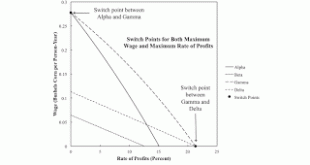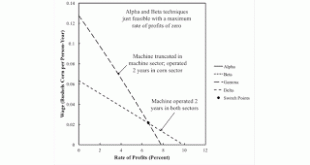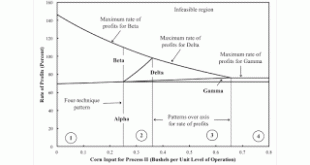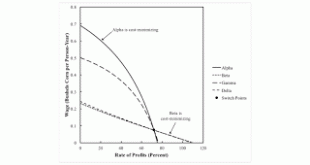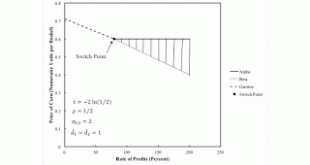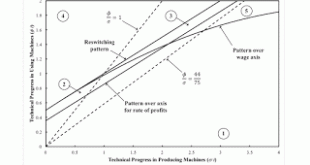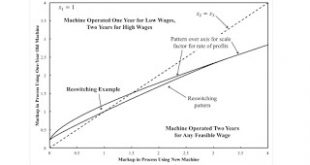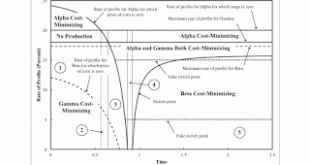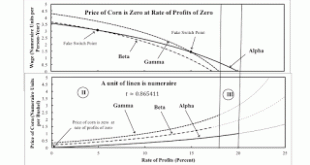Figure 1: Wage Frontier for a Fixed Capital Example1.0 Introduction I continue to explore the simplest multisector model of the production of commodities by means of commodities in which circulating and fixed capital is used in both sectors. In previous explorations, I locate a four-technique pattern, observe recurrence of truncation, and provide an example in which truncating all machines is infeasible. I think my taxonomy of fluke switch points and methods of visualizing the effects of...
Read More »Infeasibility Of All Machines Truncated
Figure 1: Factor Wage Curves For Feasible Techniques There are 12 coefficients that can be varied in my minimum multisector model in which production in all sectors can require both fixed and circulating capital. I do not think I am being very orderly in exploring this twelve-dimensional space. This is a fluke case in which the maximum rate of profits is zero for both the Alpha and the Beta techniques. If only new machines are used as means of production in producing new machines and in...
Read More »Recurrence Of Truncation In A Perturbation Analysis
Figure 1: Variation of Choice Of Technique with a Coefficient of Production This post continues the analysis of this example. The coefficients of production and the techniques are the same as in the linked post, except here I consider the results of varying a1, 2, the amount of corn needed as circulating capital in operating Process II at unit level. Figure 1 above shows how the choice of technique varies with this parameter. This is a two-sector model, in which new machines and corn are...
Read More »A Four-Technique Pattern In A Model With Fixed Capital
Figure 1: A Wage Frontier1.0 Introduction This post presents a numberic example of a non-interlocked system with fixed capital and no superimposed joint production. This seems to be the minimum multiple-sector model: Of the production of commodities by means of comodities With both circulating and fixed capital, In which the fixed capital consists of machines of non-constant efficiency with a physical lifetime of more than one period. This is a step in my research agenda of exploring...
Read More »A Fluke Case For Requirements For Use
Figure 1: Prices of Production1.0 Introduction This post presents a new kind of fluke case in the analysis of the choice of technique, at least new to me. I call this a pattern for requirements for use, and it can arise only in a case of joint production. My graphs in this post have some incomprehensible notation, since I am currently exploring perturbing parameters, in line with my research agenda. I know that perturbing the requirements for use removes the indeterminancy in this example....
Read More »A Fixed Capital System That Is Or Is Not Interlocked
I have defined patterns of switch points in considering perturbations of examples of the choice of technique. For example, I have defined three-technique and four-technique patterns. An obvious extension is to consider how these patterns arise in models of joint production. A simplification is to only consider models of fixed capital without superimposed joint production. This post lays out an example in which, maybe, some parameter values can lead to a three-technique pattern. I am...
Read More »More On A Fixed Capital Example
Figure 1: A Partition of a Parameter Space for the Schefold Example1.0 Introduction I want to revisit a perturbation analysis of an example, from Bertram Schefold, of reswitching with fixed capital. Suppose workers use a machine to produce something or other, where the machine lasts several production periods. It is a possible choice to run the machine for less than its full physical life. One might think than choosing to adopt a technique with a longer economic life of the machine...
Read More »Reswitching With Markup Pricing And Fixed Capital
Figure 1: Two Dimensional Pattern Diagram1.0 Introduction This post extends an example from Bertram Schefold. It presents markup pricing in an example with a machine that can be operated for two years or junked after one year. This is a case of joint production in which, unlike in some cases, the choice of technique can still be analyzed by the construction of the wage frontier. Also, I do not think the question of requirements for use enter in here, and all matrices are square. As usual,...
Read More »Structural Economic Dynamics and Fake Switch Points
Figure 1: A Pattern Diagram with Joint Production1.0 Introduction This post completes an example. I analyzed bits of this example here and here. This post may make no sense if you have not read a long series of previous posts or, maybe, the papers highlighted here and here. I am interested in how and if my approach to analyzing and visualizing variations in the choice of technique with technical progress extends to joint production. The example suggests fake switch points do not pose an...
Read More »A Fluke Case Over The Wage Axis
Figure 1: Wage Curves and The Price of Corn for the Fluke CaseIntroduction This post extends a previous post. I am basically introducing structural dynamics into an example, by Bidard and Klimovsky of fake switch points. At a rate of profits of zero in the example, the price of corn is zero for Alpha, one of the two techniques that is cost-minimizing there and for somewhat higher rates of profits. At a time before the fluke case, only the Gamma technique is cost-minimizing at a rate of...
Read More » Heterodox
Heterodox

